Karl Shuker's Blog, page 48
March 2, 2014
IN SEARCH OF PREHISTORIC SURVIVORS - HOW IT CAME TO BE, AND WILL BE AGAIN (CRITICS NOTWITHSTANDING!)

Of all of my 20 books, none has attracted such acclaim but also such controversy as In Search of Prehistoric Survivors. Next year will mark the 20th anniversary of its original publication in 1995, and having received countless requests from readers over the years for its republication (after having been out of print for a number of years now), I am happy to say that following a protracted period of time doing the rounds of prospective publishers, it was accepted for publication just over a year ago, and I am working upon it with a view to its achieving a timely 2015 reappearance.
Having said that, I am still uncertain as to whether to prepare a straight reprint of the text but with additional illustrations (courtesy of the many wonderful ones that have become available to me since 1995), or whether to update it – and, if I do, how extensive that update should be. Mindful of the book's enormous scope of cryptids (the only major group not represented in it are the man-beasts, and that itself was only for reasons of limited space), a major update would see the book's size grow dramatically, to the point where it might simply be financially unviable to produce it. So I need to reflect further upon that. Nevertheless, after having received so many enquiries, I can definitely confirm that Prehistoric Survivors will be returning, so watch this space!
Meanwhile, and after having given the matter much thought, I feel that it may be instructive to reveal precisely how this particular book of mine came to be, because ever since it appeared in 1995 there has been a degree of confusion and controversy in some quarters as to where I stand in relation to its theme and contents. Consequently, I hope that the following explanation (which I have already outlined privately to various colleagues down through the years but have never bothered disclosing publicly before) elucidates all of this satisfactorily.
In many ways, this book is the most unusual of any of mine, inasmuch as its final, published form was not how I had originally conceived it at all. Let me explain. Following the publication in 1991 of my second book, Extraordinary Animals Worldwide, I was planning a major book on herpetological cryptids – everything from alleged living dinosaurs, pterosaurs, and plesiosaurs, to mystery lizards of many kinds, giant snakes and crowing serpents, chelonian cryptids of all shapes and sizes, anomalous amphibians, and even a major section devoted to the possible origin of and inspiration for the world's plethora of legendary dragons.
A synopsis of this proposed book did the rounds of publishers (during which time, incidentally, my third book, The Lost Ark: New and Rediscovered Animals of the 20thCentury, was published, in late 1993), with Blandford Press being particularly interested in it (and ultimately publishing it two years later). Mindful, however, of the enormous worldwide popularity of Steven Spielberg's blockbuster movie Jurassic Park at that time (the first film had been released in 1993), they suggested a fundamental change to the contents and slant of my book. Instead of confining it to herpetological mystery beasts, they proposed that I should expand its range of subjects to that of cryptids spanning the entire zoological spectrum, but concentrate exclusively upon those that have been suggested at one time or another by cryptozoologists to constitute prehistoric survivors.
It was certainly a most intriguing brief, albeit very different from my original concept, and one that I therefore decided to accept, even though – and I must emphasise this unequivocally here - I did not personally consider it likely that all of those cryptids truly were prehistoric survivors. But my personal opinion was irrelevant as far as the book's brief was concerned. What was required was for me to present a dossier of reports and native traditions for each cryptid, and then assess them in the context of whichever prehistoric creature(s) it had been likened to in the cryptozoological literature (with theories not appertaining to prehistoric survival receiving only minimal treatment, as they were not the focus of this study). So that is precisely what I did. Consequently, out went most of the mystery lizards and amphibians as well as the snakes and also the dragons section, and in came putative mammalian methusalehs like chalicotheres, thylacoleonids, amphicyonids, and sabre-tooths, alleged lingering avians like teratorns and Sylviornis, the giant carnivorous shark megalodon, and even some reputed eurypterid survivors.
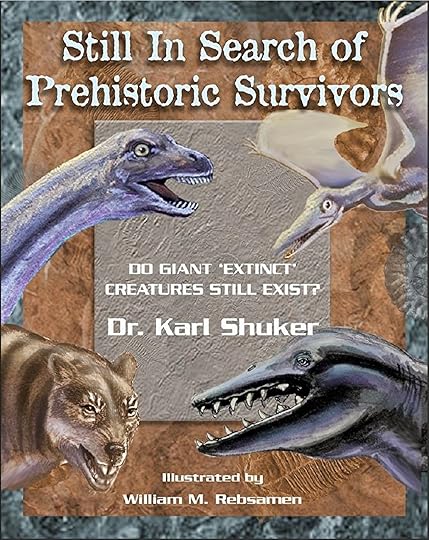 A stunning cover design prepared by cryptozoological artist William Rebsamen for a proposed updated, retitled edition of In Search of Prehistoric Survivors(© William Rebsamen)
A stunning cover design prepared by cryptozoological artist William Rebsamen for a proposed updated, retitled edition of In Search of Prehistoric Survivors(© William Rebsamen)During the years that have followed, the concept of prehistoric survivorship – or what British palaeontologist Dr Darren Naish refers to as the Prehistoric Survivor Paradigm (PSP) - has received some harsh criticism from cryptozoological sceptics. And indeed, I am the first to concede that such survival becomes increasingly untenable the greater the span of time that exists between any modern-day cryptid and its most recent alleged fossil antecedents (i.e. its so-called ghost lineage, with the cryptid itself thereby constituting a Lazarus taxon). However, as my trilogy of books on new and rediscovered animals have disclosed time and again, some truly extraordinary, spectacular, and entirely unpredictable, unexpected zoological discoveries have been made in modern times.
And yes, these do indeed include some bona fide prehistoric survivors, taxa known only from fossils until living representatives were unveiled - e.g. the Chacoan peccary, mountain pygmy possum, Bulmer's fruit bat, kha-nyou, goblin shark, neoglyphean crustaceans, monoplacophoran molluscs, and of course the coelacanth. (And yes again, I am well aware that post-Mesozoic coelacanth fossils are now known, but these were only uncovered and recognised for what they were after the discovery in 1938 of the living Latimeria, when the unexpected resurrection of this ancient lineage of fishes no doubt acted as a significant spur to palaeontologists to seek post-Mesozoic coelacanth fossils that they now knew must exist if suitably preserved, and which would help to close up what could now be seen to be a very extensive and therefore anomalous ghost lineage for these fishes; so at its time of discovery, the modern-day coelacanth was definitely a valid prehistoric survivor.) Hence I remain reluctant to discount PSP out of hand.
Having said that, although I have often been accused of "believing" that a given cryptid is a particular type of prehistoric survivor, this is simply not true, for the simple reason that it is impossible to state definitely (although certain cryptozoologists habitually attempt to do so) what a given cryptid must be. Without tangible evidence to examine (and I am referring here to physical remains, not photographic evidence, which can be convincingly faked with alarming ease nowadays), all that can be done is pass a personal opinion as to how likely or unlikely a given identity appears to be. However, opinions are not facts, and should never be put forward, or be mistaken, as such. In short, therefore, I do not "believe" that any cryptid is any specific identity – I merely indicate what I personally consider to be likely (or unlikely) identities for it, nothing more.
Reviving this book has posed something of a dilemma for me, because doing so meant that its original brief (and also therefore my own misgivings regarding the plausibility of prehistoric survival for certain of its cryptids) would remain fundamental to its raison d'être. The only alternative would be for me to rewrite it completely, with an entirely altered slant, but the result of that would be not only a totally different but also a much more extensive book – so extensive, in fact, that (as with updating it even in its original form) I sincerely doubt whether it would be financially viable for any publisher to take on. Yet whatever one's own personal opinion may be concerning prehistoric survival in any capacity, the wealth of historical reports and cryptozoological coverage presented in its pages is such that it would be a tragedy for this book to remain out of print, especially when – as I have been made continually aware for many years – there is a very considerable demand among readers for it to reappear.
Consequently, now that I have outlined here how it came to be and why it is what it is, so that there can no longer be any confusion or contention regarding it, I am very happy to engage upon recalling back into existence what many people consider to be my finest cryptozoological volume. When complete, it may contain various updates and certainly some major new illustrations, but its basic context and content will otherwise remain unchanged.
Last, but definitely not least, I wish to thank most sincerely all of its numerous supporters for their kind words through all the intervening years, urging me to resurrect it - just like a veritable prehistoric survivor itself, in fact!
 The eyecatching original cover design for In Search of Prehistoric Survivors, prepared by artist Kevin Maddison and featuring a very striking Queensland tiger or yarri (albeit one with enlarged canines like placental felids, rather than with enlarged incisors like thylacoleonids!), but which the publisher ultimately rejected in favour of the plesiosaur flipper cover – ah, well... (© Kevin Maddison)
The eyecatching original cover design for In Search of Prehistoric Survivors, prepared by artist Kevin Maddison and featuring a very striking Queensland tiger or yarri (albeit one with enlarged canines like placental felids, rather than with enlarged incisors like thylacoleonids!), but which the publisher ultimately rejected in favour of the plesiosaur flipper cover – ah, well... (© Kevin Maddison)
Published on March 02, 2014 10:28
February 28, 2014
TEN OF MY FAVOURITE CRYPTOZOOLOGY-LINKED LOCATIONS IN BRITAIN
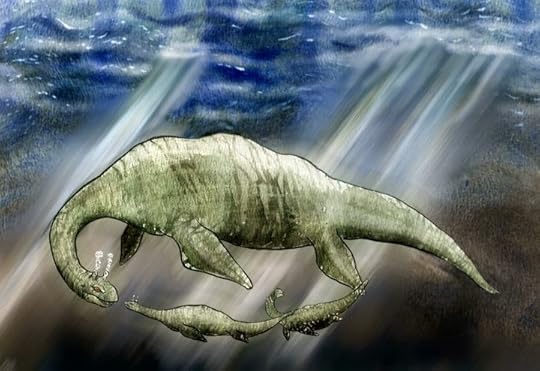 Nessie and family ((c) Richard Svensson)
Nessie and family ((c) Richard Svensson)What do Cannock Chase, Renwick, Exmoor, Drummans, Falmouth Bay, and Bala Lake all have in common? If I added Loch Ness to the list, I'm sure that you'd guess much more readily. Yes indeed, they are all locations in Britain linked to sightings of mystery creatures. I recently wrote an online article for Enterprise Magazine, presenting ten of my favourite weird and (very) wonderful British crypto-locations, which can be accessed by clicking here.
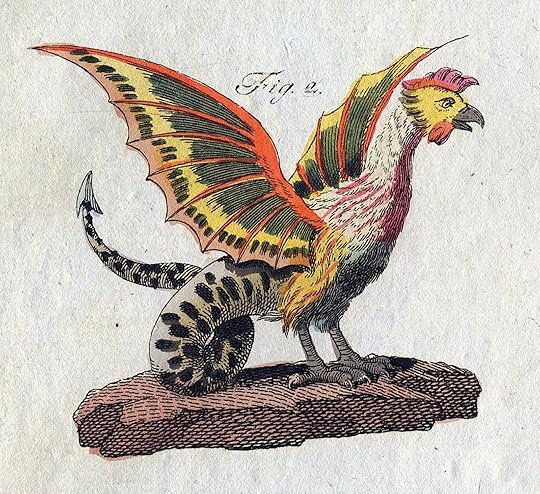 Cockatrice (Friedrich Justin Bertuch)
Cockatrice (Friedrich Justin Bertuch) So if you fancy travelling around the country in search of lake monsters and sea serpents, mermaids and master otters, owlmen, cockatrices, werewolves, alien big cats, and even a British bigfoot or two, now you know just where to go. Have fun!
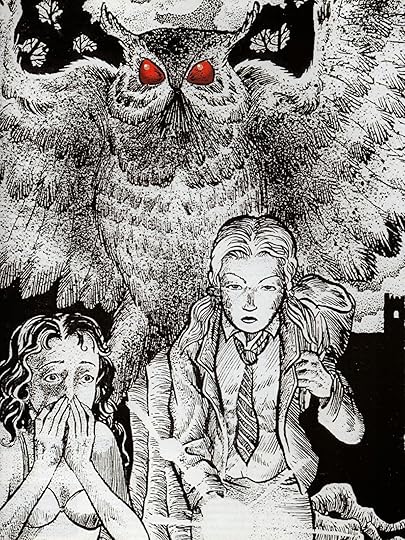 Cornish owlman ((c) Richard Svensson)
Cornish owlman ((c) Richard Svensson)
Published on February 28, 2014 12:15
February 24, 2014
THE SHAMIR AND THE STONE WORM
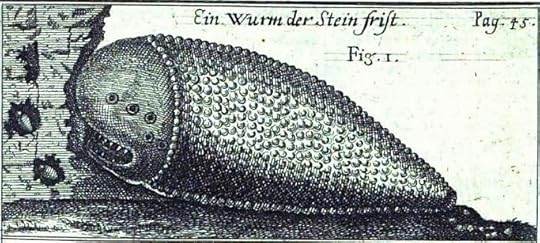 st1\:*{behavior:url(#ieooui) } The first of two engravings of a medieval and highly mysterious stone worm contained within a late 17th-Century book by Eberhard Werner Happel
st1\:*{behavior:url(#ieooui) } The first of two engravings of a medieval and highly mysterious stone worm contained within a late 17th-Century book by Eberhard Werner HappelThere are a number of mysterious and controversial biblical creatures with potential relevance to cryptozoology, of which the most famous examples are undoubtedly Leviathan and Behemoth (click here and here to see my ShukerNature investigations of them). Much less famous but no less remarkable than those two, however, is the small yet highly intriguing subject of this present ShukerNature post - the shamir.
Also spelled 'samir' or 'schamir', this is the Hebrew name given to a tiny worm-like creature referred to in certain Jewish holy books, including the Midrashim and the Talmud (particularly the Gemara – the component of the Talmud that consists of rabbinical analysis of, and commentary upon, an earlier work known as the Mishnah).
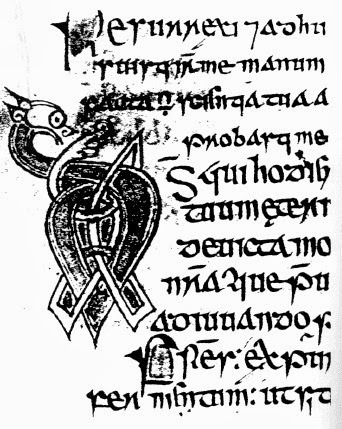 The shamir as depicted within the Rosslyn Missal (an Irish manuscript dating from the late 13th or early 14th Century)
The shamir as depicted within the Rosslyn Missal (an Irish manuscript dating from the late 13th or early 14th Century)According to Jewish tradition contained within these and other sources, the shamir was created by God at twilight upon the Sixth Day of the Hexameron (the six days of Creation). Although it was only the size of a single grain of barley corn, the shamir was so incredibly powerful that merely its gaze was sufficient to cut through any material with ease, even through diamond itself, the hardest substance on Earth. Such a miraculous creature needed to be safeguarded, and so God entrusted the shamir to the hoopoe (or woodcock or moorhen, depending upon which version of the legend is consulted), commanding this bird to protect the shamir from all harm.
In order to contain this mighty if minuscule worm, the hoopoe placed it among a quantity of barley corns, then wrapped them all up together in a woollen cloth, which in turn was placed inside a box fashioned from lead – the only material strong enough to contain the shamir effectively but without disintegrating from the intensity of its laser-like gaze. So here, safely and comfortably ensconced within its leaden domicile, which was retained by the hoopoe in the Garden of Eden, it passed through all the ages that followed.
 Hand-coloured engraving of a hoopoe from 1840
Hand-coloured engraving of a hoopoe from 1840Only once did the shamir emerge – during the time of Aaron and Moses, when God commanded the hoopoe to lend this worm to Him for the etching of the names of the 12 tribes of Israel upon the precious stones on 12 special priestly breastplates (the Hoshen), one breastplate for each of the tribes and each breastplate composed of a different stone. The task was a very difficult one, but the shamir accomplished it so expertly that not a single atom of precious stone was lost or destroyed.
After this, the shamir was placed back inside its lead casket, entrusted once more to the hoopoe's care, and there it remained, in undisturbed obscurity – until the time of King Solomon the Wise. Solomon wished to erect a glorious temple, but he was very mindful of God's instructions, laid down long ago to Moses, that no place of worship, not even an altar (let alone a temple), should be constructed using any tool made from iron - because iron was a substance of war, and that if anything related to war should ever touch a place of worship, it would be instantly and irrevocably defiled. But if Solomon could not use iron tools, how could the stones needed for constructing his temple be hewn?
 An etching of the famous and much-exhibited model of Solomon's Temple created during the 1600s by Rabbi Jacob Jehudah Leon, which measured 80 ft in circumference and 13 ft high, and was based upon information contained within the Bible's Book of Kings, Book of Samuel, and Book of Chronicles
An etching of the famous and much-exhibited model of Solomon's Temple created during the 1600s by Rabbi Jacob Jehudah Leon, which measured 80 ft in circumference and 13 ft high, and was based upon information contained within the Bible's Book of Kings, Book of Samuel, and Book of ChroniclesIn an attempt to solve this riddle, Solomon enquired far and wide, and eventually he learnt about the incredible stone-searing shamir. Determined to utilise its extraordinary power, Solomon dispatched a servant to seek out this wonderful creature and bring it back to him. After a long search, the servant succeeded, and Solomon duly employed the shamir to cut the rocks required for building his celebrated temple – the First Temple in Jerusalem. But that is where the story ends abruptly – because after this magnificent edifice was completed, the shamir allegedly lost its power, then vanished, and has never been heard of again…or has it?
I had always assumed that the shamir was entirely mythical – until 28 November 2013, that is, when Facebook friend Robert Schneck very kindly brought to my attention an astonishing but hitherto exceedingly obscure mystery beast that seemed at least on first sight to be a veritable shamir of the Middle Ages. Robert revealed to me two engravings of bizarre-looking beasts known as vermes lapidum or stone worms, and which had appeared in a hefty German tome authored by Eberhard Werner Happel and entitled Relationes Curiosae, oder Denckwürdigkeiten der Welt, which was originally published in five volumes between 1683 and 1691.
 Two engravings of alleged stone worms from Happel's Relationes Curiosae, oder Denckwürdigkeiten der Welt
Two engravings of alleged stone worms from Happel's Relationes Curiosae, oder Denckwürdigkeiten der WeltAccording to Happel, the stone worms had originally been brought to public attention by a 17th-Century monk called de la Voye, from a Normandy monastery, who in 1666 had written a letter to a Lord Auzout describing his remarkable discovery. One day, de la Voye had found some of these very small, decidedly odd-looking creatures moving about incessantly inside some holes of their own making in an old wall, much of whose rocky composition had allegedly been eaten away and converted into dust by the devouring nature of the worms. When he pulled out some of them and examined them under a magnifying glass, the monk observed that they were each the size of a single barley corn (the very same description, intriguingly, as used in the Jewish holy books for the shamir) and enclosed in a grey shell, as depicted in the first (labelled Fig. 1) of the two engravings presented above. As quoted by Happel in his book, the monk continued his account of the stone worms in his letter to Lord Azout as follows:
"…on the tip [of the worm's body] there is a hole, through which the excrements can be excreted. On the other end there is a larger hole, trough which the head can be protruded.
They are entirely black, the body shows various segments, near the head there are three legs, each has two joints, not dissimilar to these of a flea.
When they move their body is suspended in air, the mouth but is still oriented to the rock. The head is bulky, a bit smooth, similar in shape and colour to the shell of a snail...also the mouth is similar large, with four kinds of teeth disposed in cross like manner."
The second engraving (Fig. 2) presumably shows the stone worm in a more advanced state of development than in Fig. 1, as it is now equipped with three pairs of legs. However, both forms seem only to possess small, primitive, laterally-sited ocellus-like eyes (round and black, according to de la Voye), rather than large, compound eyes, thereby indicating that if the stone worm is an insect, as seems at least remotely possible, it is a larval form rather than an adult (larval insects do not possess compound eyes, only ocelli).
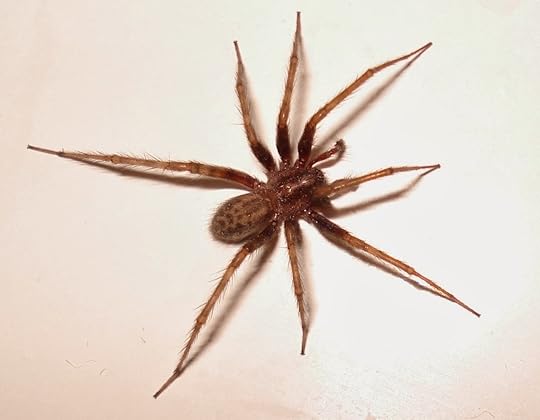 Tegenaria domestica
, a common species of funnel-weaving spider
Tegenaria domestica
, a common species of funnel-weaving spiderConversely, some authors have sought to discount the stone worms as (very) fanciful representations of funnel-weaving spiders, three pairs of legs rather than four notwithstanding and the stone worms' reputed rock-devouring proclivities discounted as apocryphal. Perhaps the presence of multiple ocelli, a characteristic of many spiders (which never possess compound eyes like most adult insects do), influenced their choice of an arachnid identity for these creatures, as there seems little else that would have done so? Certainly, the heavily segmented abdomen of the creature in the second engraving, and the seemingly limbless, shelled form of the creature in the first one, present major problems in reconciling them with any spider.
To be honest, however, the creatures depicted in these two engravings are so bizarre that it is impossible to identify them confidently with any known animal form. If they were indeed real, and not a hoax perpetrated by de la Voye, we can only assume that these engravings are exceedingly fanciful representations, so much so that the worms' true morphology has been enshrouded in exaggeration or error.
As for their stone-devouring diet, this too is baffling in the extreme. Perhaps de la Joye saw these creatures amid the wall's crumbling masonry and wrongly presumed that they were responsible? Who can say? All that can be stated is that except for a couple of brief mentions in some early 18th-Century dictionaries of natural science, the stone worm rapidly faded into total scientific oblivion shortly after Happel's book was published.
 Happel's Relationes Curiosae, 1683
Happel's Relationes Curiosae, 1683Could it be that, as a monk, de la Voye was well-read across a wide spectrum of religious tracts, was therefore familiar with the mythical shamir from Jewish holy books, and had mistakenly thought that the creatures that he had discovered were similar? In reality, however, even his stone worms' ostensible comparability to the shamir does not stand up to close scrutiny. For whereas the latter beast disintegrated and annihilated rocks using its formidable, basiliskian gaze, the stone worm actually devoured rocks and stones, at least according to de la Voye's testimony.
Almost 350 years have passed since de la Voye wrote his intriguing letter documenting the stone worms, but its subjects remain as mystifying and as unsatisfactorily 'explained' today as they were then. Unless the entire episode of their discovery was indeed a hoax and a nonsense, the stone worms must have been something – but what?
 The second of two engravings of a medieval and highly mysterious stone worm contained within a late 17th-Century book by Eberhard Werner Happel
The second of two engravings of a medieval and highly mysterious stone worm contained within a late 17th-Century book by Eberhard Werner Happel
Published on February 24, 2014 06:25
February 23, 2014
DOMINICA'S DEAD PARROT - A PERFECT PICTURE OF MYSTERY?
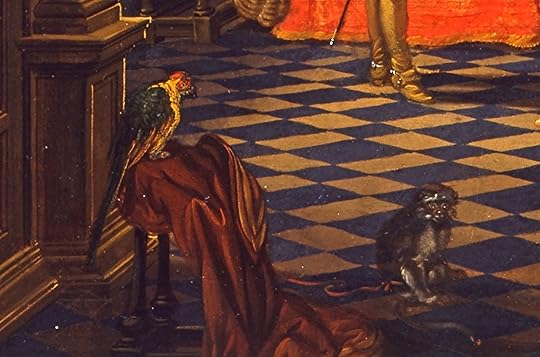 st1\:*{behavior:url(#ieooui) } Close-up of the mystery parrot in Bartholomeus van Bassen's famous painting 'Renaissance Interior With Banqueters' (1618-1620) (this high-res image supplied to me courtesy of Michael Klauke, Associate Registrar for Collections at the North Carolina Museum of Art)
st1\:*{behavior:url(#ieooui) } Close-up of the mystery parrot in Bartholomeus van Bassen's famous painting 'Renaissance Interior With Banqueters' (1618-1620) (this high-res image supplied to me courtesy of Michael Klauke, Associate Registrar for Collections at the North Carolina Museum of Art)In various of my books, magazine articles, and ShukerNature blog posts, I have documented a number of mystery birds that have appeared in paintings by famous artists and which may conceivably represent lost species undescribed by science. In recent times, several additional examples have come to my attention, but perhaps the most significant of these is the following one, which may feature a hitherto-unrecognised depiction of a long-extinct bird officially known only from a single verbal description.
Bartholomeus van Bassen (1590-1652) was a celebrated Dutch architect and painter. Perhaps his most famous painting was 'Renaissance Interior With Banqueters' - an extremely detailed, sophisticated work of art that took from 1618 to 1620 to complete. Having said that, although I naturally cannot help but be highly impressed by its scale and by the architectural splendours and opulence that it depicts, the most fascinating aspect of it for me is an ostensibly insignificant bird perching upon a chair in this painting's bottom left-hand corner. Closer examination of this bird reveals it to be a parrot, but it does not appear to correspond with any species known to be living today. What could it be?
 Bartholomeus van Bassen's famous painting 'Renaissance Interior With Banqueters' (1618-1620) (this high-res image supplied to me courtesy of Michael Klauke, Associate Registrar for Collections at the North Carolina Museum of Art)Please click painting to view it in greatly-enlarged form.
Bartholomeus van Bassen's famous painting 'Renaissance Interior With Banqueters' (1618-1620) (this high-res image supplied to me courtesy of Michael Klauke, Associate Registrar for Collections at the North Carolina Museum of Art)Please click painting to view it in greatly-enlarged form.Whenever an identification of a mystifying bird in a painting is attempted, it should always be borne in mind that artists have often included entirely fictitious examples in their works, simply to enhance their visual appeal. In this particular case, conversely, van Bassen's painting is so meticulously executed and so accurate in all other details, including those of other creatures included in it, that it seems highly unlikely that he would have added a made-up bird.
This fascinating case was first brought to my attention during spring 2012 ago by pet expert and fellow author David Alderton, with whom I have since corresponded in some detail concerning this mystery parrot. With regard to the possibility that it is an ornithological invention on van Bassen's part, David shares my own view that this is improbable:
"What I would say is that the other animals in the scene are very clearly recognisable. Based on its position in the painting, and its perch on rare/expensive material, this tends to suggest that this parrot is significant. It would have been rare and exotic of course - representing a flamboyant display of wealth in a very clear visual way, and I can't see it would have been a "fictional" bird."
So if we assume that the parrot represents a bona fide species, are there any that resemble it in some way?
On first glance, it recalls the Carolina parakeet Conuropsis carolinensis, a predominantly green-plumaged species with a bright yellow head marked with red. Once common in North America, it suffered greatly from habitat destruction, from being captured for the pet trade, and by being heavily persecuted due to its fondness for farmers' crops, until the last confirmed specimen died in Cincinnati Zoo in 1918. Closer observation, however, reveals a number of marked differences between this now-demised species and van Bassen's painted parrot.
 John James Audubon's famous painting of Carolina parakeets (eastern subspecies)
John James Audubon's famous painting of Carolina parakeets (eastern subspecies) The latter has golden-yellow underparts, whereas the Carolina parakeet's were green; it also has yellow lateral tail feathers whereas all of the Carolina's tail feathers were green; its wing primaries are red, not green like the Carolina's; the red markings on its head are more extensive than the Carolina's; and its relative proportions are very different from the Carolina's. Van Bassen's parrot has a much longer tail, a more powerful beak, and, judging scale from the chair upon which it is perched, a much larger overall body size. Indeed, in general appearance, the category of parrots that it most closely agrees with is the macaws.
Consequently, attempts to liken it to various small species of South American conure parakeet, such as the sun conure Aratinga solstitialis and the jenday conure A. jandaya, are not satisfactory either, unless of course the bird has been badly painted, with incorrect plumage and/or dimensions. For all of the reasons already discussed in relation to the prospect of its being a fictitious species, however, this notion seems untenable.
 Two jenday conures (left and middle) and a sun conure (right) ((c) Chris Gladis/Wikipedia)
Two jenday conures (left and middle) and a sun conure (right) ((c) Chris Gladis/Wikipedia) However closely one studies images of a painting, even close-up ones of a specific section of it, there can be no substitute for viewing the painting itself directly. Happily, David Alderton was able to do precisely this, when 'Renaissance Interior With Banqueters' was on display several years ago at the National Gallery in London. As a result, he noticed various features of the parrot not readily visible even in close-up images of it. These include the presence of a white brow line above its eye, and, of particular interest, the extensive amount of bare white facial skin – a feature that is characteristic of macaws. Usually this area is limited to the sides of the face around the eyes, and at the beak's base, but in van Bassen's bird it also extends onto the top of the head.
After viewing the bird directly in the painting, David wondered whether it may be a Cuban red macaw Ara tricolor, whose last confirmed wild specimen was shot in 1864, since when this species has been deemed to be extinct. However, in a short account of van Bassen's mystery parrot that he posted on his Pet Info Club website (http://www.petinfoclub.com/Collectibles/Painting_portrays_extinct_parrot.aspx), he conceded that the Cuban macaw's plumage exhibited certain noticeable differences from the latter's, which indeed it does. The most significant of these are the Cuban red macaw's blue wing primaries, its red cheeks, neck, and underparts, its red and blue tail feathers, and the much less extensive area of white facial skin. Exit the Cuban red macaw from further consideration.
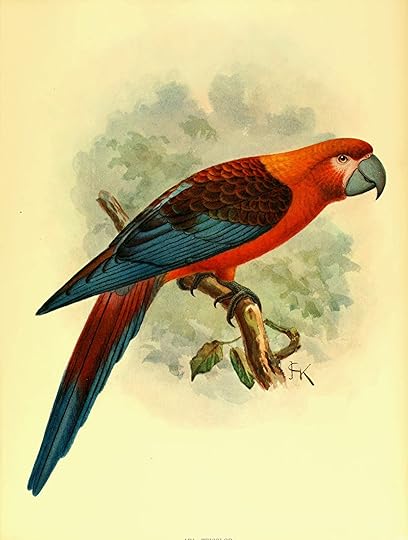 Cuban red macaw (from Walter Rothschild's book Extinct Birds, 1907)
Cuban red macaw (from Walter Rothschild's book Extinct Birds, 1907) However, the Cuban red macaw is not the only extinct Caribbean macaw on record. Several additional species from a number of different West Indian islands – including Guadeloupe, Jamaica, Dominica, Hispaniola, and Martinique - have also been described and named (click here for a detailed ShukerNature article of mine investigating these mystery macaws). Yet whereas the Cuban is physically represented in various museums by a number of preserved specimens, these others are known only from eyewitness descriptions (plus some paintings based solely upon them, not directly upon living specimens). And some of those descriptions are so vague that ornithologists have dismissed certain of the Caribbean's 'lost' macaws as hypothetical species - originating from confusion with known parrots, or even based upon specimens of various South American species of macaw introduced into the West Indies as pets that may have subsequently escaped.
One of the most interesting of these Caribbean mystery macaws is the Dominican green and yellow macaw Ara atwoodi, named after traveller Thomas Atwood, whose History of the Island of Dominica (1791) contains the following informative account of it:
"The mackaw [sic] is of the parrot kind, but larger than the common parrot [this latter parrot actually constituting two separate but closely-related species of much smaller Amazon parrot], and makes a more disagreeable, harsh noise. They are in great plenty, as are also parrots in this island; have both of them a delightful green and yellow plumage, with a scarlet-coloured fleshy substance from the ears to the root of the bill, of which colour is likewise the chief feathers of the wings and tails. They breed on the tops of the highest trees, where they feed on the berries in great numbers together; and are easily discovered by their loud chattering noise, which at a distance resembles human voices. The mackaws cannot be taught to articulate words; but the parrots of this country may, by taking pains with them when caught young. The flesh of both is eat [sic = edible], but being very very fat, it wastes in roasting, and eats dry and insipid; for which reason, they are chiefly used to make soup of, which is accounted very nutritive."
It certainly must have been, because however plentiful these macaws were in Atwood's day, their numbers must have swiftly diminished thereafter, because his description is all that remains to suggest that they ever existed at all. No other reports of them, and no preserved specimens or paintings of living specimens, are known – unless...
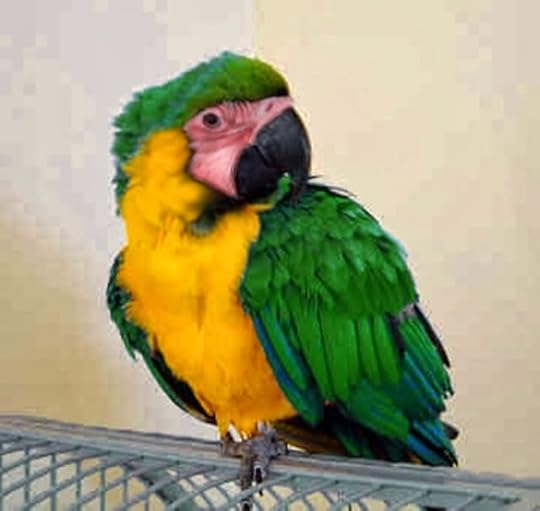 A photoshop-created representation of the Dominican green and yellow macaw's possible appearance in life ((c) Rafael Silva do Nascimento)
A photoshop-created representation of the Dominican green and yellow macaw's possible appearance in life ((c) Rafael Silva do Nascimento) There is no doubt that Atwood's description of the Dominican green and yellow macaw accords well with the parrot in van Bassen's painting - incorporating the precise configuration of its head's red colouration, its red wing feathers, and obviously its predominantly green and yellow plumage. True, Atwood did not mention any area of white on the Dominican macaws' faces, but it is worth noting that in some species of macaw this region turns red if the bird becomes excited, so perhaps he simply didn't observe any macaws when in a quiescent state, only when they were squawking animatedly while feeding.
Consequently, the only inconsistency in appearance between van Bassen's bird and Atwood's Dominican macaws is the mention of red tail feathers in his description, whereas the central tail feathers of van Bassen's parrot are green and the lateral ones are yellow. Perhaps, however, there was a slight degree of variation in the plumage colouration of the Dominican macaw (sexual dimorphism, for instance?) that could account for this discrepancy? In all other respects, the match is much closer than for any other species, living or extinct.
In 2011, a year beforeI made known to him the mystery parrot in van Bassen's painting, Brazilian bird artist Rafael Silva do Nascimento had prepared a beautiful painting of his, own reconstructing the likely appearance of the Dominican green and yellow macaw as based upon Atwood's description of it, which is reproduced here with Rafael's kind permission. As you can see, his macaw and van Bassen's parrot, prepared entirely independently of one another, accord very closely indeed, providing further confirmation of just how well Atwood's verbal description compares with van Bassen's painted bird.
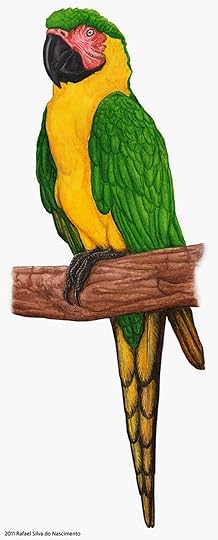 Rafael Silva do Nascimento's painting of the Dominican green and yellow macaw ((c) Rafael Silva do Nascimento)
Rafael Silva do Nascimento's painting of the Dominican green and yellow macaw ((c) Rafael Silva do Nascimento)So could it be that the enigmatic parrot perched in this highly-renowned Dutch artist's early 17th-Century painting was a living Dominican green and yellow macaw, brought back to Europe as an eyecatching pet by (or for) a wealthy Dutch citizen? During that period, all manner of rare and extremely exotic fauna were being transported here from every known corner of the globe, many of which had never before been seen in Europe. Consequently, a colourful macaw would be nothing special or unexpected on that score.
What would be very special, and extremely unexpected, conversely, is if the macaw species in question subsequently became extinct but its exquisite appearance was preserved under the very nose of every art-lover in an extremely famous, spectacular painting, yet without its identity or zoological significance being recognised – until now?
If true, this is a great tragedy. After all, to paraphrase a certain classic comedy sketch from the golden age of British television, it may be an ex-parrot, but it had lovely plumage.
I wish to offer my sincere thanks to David Alderton for bringing this extremely intriguing crypto-ornithological mystery to my attention and for kindly sharing his thoughts and information concerning it with me; to Michael Klauke, Associate Registrar for Collections at the North Carolina Museum of Art, for most generously making available to me some high-resolution and close-up images of van Bassen's painting and its mystifying parrot; to Rafael Silva do Nascimento for very kindly permitting me to include his Dominican macaw painting here and also for providing me with a copy of Atwood's original description of Dominica's macaws; and to all of my Facebook friends who offered opinions and suggestions regarding this painted bird's possible identity when I posted an enquiry regarding it on my FB Wall in April 2012.
 Reconstructions of the likely appearance of the various extinct species of West Indian macaw that have been reported by various travellers and subsequently named by scientists ((c) Rafael Silva do Nascimento)
Reconstructions of the likely appearance of the various extinct species of West Indian macaw that have been reported by various travellers and subsequently named by scientists ((c) Rafael Silva do Nascimento)
Published on February 23, 2014 05:06
February 18, 2014
BIRD-EATING DEER AND FLESH-EATING SHEEP – A GRUESOME SELECTION OF UNEXPECTED HOOFED CARNIVORES
 Red deer - not always strictly vegetarian
Red deer - not always strictly vegetarianOriginally uploaded onto YouTube on 16 May 2010, but currently going viral again, is a short wildlife video by Linda Ford from the USA that films in her own front yard the macabre scene of a subadult buck deer casually picking up a young bird off the ground with its teeth, chewing the helpless creature in its jaws, and then swallowing it, while the two parent birds flap desperately but impotently in the devouring deer's face. Click here to watch Linda's astonishing but genuine video on YouTube.
A bird-eating deer? Incredible – impossible, surely? – yet perfectly true. Nor is it a unique case. Back in 1997, I included a section on sinister, unexpected carnivores of the hoofed - and normally strictly herbivorous, vegetarian - variety in my book From Flying Toads To SnakesWith Wings . Here is what I wrote:
The Inner Hebrides are a group of islands situated off the western coast of Scotland. One of their southernmost members, Rhum, is home to more than 300 red deer Cervus elaphus. On small islands like this, the vegetation is often deficient in minerals - minerals that are required by large herbivorous animals. Faced with this situation, deer normally resort to chewing their own shed antlers, or even old bones, in order to obtain the missing substances, including calcium and phosphorus. But on an island like Rhum, which is also home to large colonies of ground-nesting seabirds, there is a much more sinister method available to the deer for sustaining a balanced diet.
Quite simply, they decapitate the chicks of the seabirds, particularly those of an albatross-related species known as the Manx shearwater Puffinus puffinus - and thence obtain from the chicks' bones the minerals that they lack in their normal vegetarian diet.
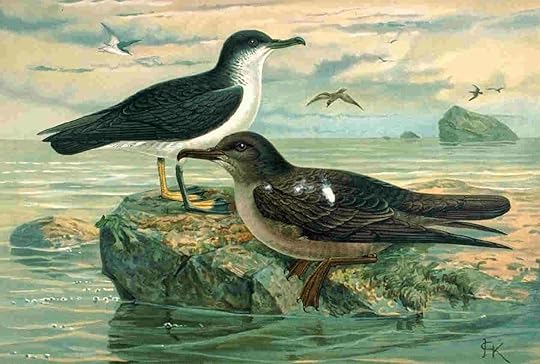 Manx shearwater (left) plus sooty shearwater (right)
Manx shearwater (left) plus sooty shearwater (right) The researcher responsible for exposing this dark and previously unrealized secret in the history of Britain's largest and most noble species of native wild mammal is biologist Dr Robert Furness, from the University of Glasgow in Scotland. However, his deer disclosures, first formally documented in the Journal of Zoology (March 1988), were only the beginning. When he visited another group of Scottish islands, the Shetlands, he uncovered an even more amazing example of carnivores of the cryptic kind.
During the 1990s, Furness has been studying a herd of primitive sheep on the small Shetland island of Foula, the most westerly member of this group. These animals are direct descendants of sheep introduced here long ago by the Vikings, and in order to obtain adequate supplies of minerals - notably phosphorus - present in insufficient quantities within Foula's sparse vegetation, the sheep have evolved a merciless modus operandi that closely parallels the grisly dietary deviation exhibited by the red deer of Rhum. The Arctic tern Sterna paradisaea is an abundant seabird nesting on Foula - and the sheep prey upon their fledglings. Unlike the deer, however, they rarely amputate the heads of the young birds. Instead, they prefer to bite off their victims' wings and legs, often leaving the helpless fledglings still alive but lethally crippled. The sheep then procure the required minerals by chewing the bones in the birds' severed limbs.
As is so often true when investigating cases of anomalous animal behaviour, it transpired that the crofters who live on Foula have always known that this island's sheep were bird killers, but until the first-hand observations and studies by Furness vindicated them, their claims had been dismissed by science as nothing more than quaint folklore.
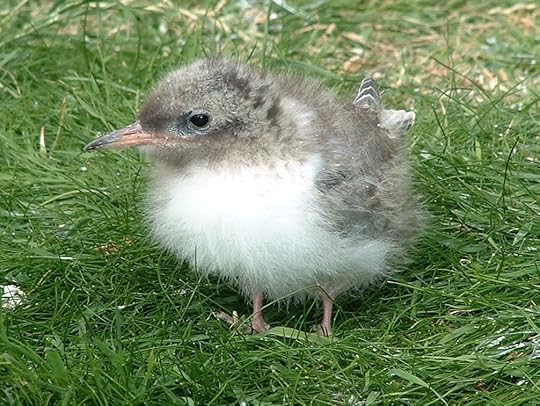 Arctic tern fledgling
Arctic tern fledgling Since I wrote the above account, many additional cases of what appears to be opportunistic but quite possibly natural (albeit hitherto little-realised) carnivorous behaviour among typically herbivorous mammalian species have been documented and formally confirmed - including white-tailed deer Odocoileus virginianus in North America eating songbirds and small mammals snared in mist nets, various domestic cows in India eating live chickens, a goose-eating rhinoceros, and even a rabbit-devouring deer (check YouTube for several videos featuring some such examples). But perhaps the most gruesome case of a flesh-eating herbivore ever recorded featured a captive elephant that killed and ate a human! And yes, I did document this grotesque event in my book:
Rather more mundane incidents, involving cattle and even hippopotamuses eating the bones of dead brethren to boost their dietary intake of minerals, have also been recorded over the years - but nothing, surely, can compare with the astounding, yet fully verified case of World War II's woman-eating elephant.
This dramatic episode was revealed by internationally renowned zoovet Dr David Taylor. During the final years of World War II, Germany was suffering from severe food shortages, and its zoo animals could not always be given the balanced diets that they had customarily received in peacetime. However, a male elephant in Berlin Zoo apparently succeeded in solving its mineral deficiency problems, albeit in a singularly horrific manner.
A lady called Bertha Walt, who worked at an office near to the zoo, made a habit of spending her lunchtime in the zoo and feeding the remains of her sandwiches to this elephant. One day, she learned upon her arrival at the elephant's enclosure that he was unwell. Saddened by her pachyderm friend's illness, Walt unhesitatingly volunteered to stay with him overnight, in order to nurse him and to provide reassuring company for him.
Given permission to do this, she duly spent the evening inside the elephant's enclosure - but when the animal's keeper arrived the next morning to take over, his unbelieving eyes registered a terrible sight. Walt was still there - or, to be more precise, parts of her were still there. The rest of her had been devoured by the elephant!
All of which assuredly gives a whole new depth of meaning to the popular old saying "All flesh is grass"!

Published on February 18, 2014 13:43
February 16, 2014
CONTEMPLATING THE CON RIT

Tim Morris's excellent reconstruction of the con rit as a giant marine crustacean, based upon my proposed identity for it in my 1995 book In Search of Prehistoric Survivors (© Tim Morris)
When it debuted in his classic tome In the Wake of the Sea-Serpents (1968), Dr Bernard Heuvelmans's bold classification of sea serpents into no less than nine well-defined types was widely hailed within the cryptozoological community as a milestone in cryptid research, and it is still widely referred to today. However, the validity of certain of those sea serpent types has subsequently been challenged by various other researchers, due to revelations that cast doubt upon or totally discredit those types' proposed taxonomic identities.
Perhaps the most controversial of Heuvelmans's nine sea serpent types is his many-finned sea serpent Cetioscolopendra aeliani, for which he nominated a living species of armoured, scaly archaeocete as its identity. Unfortunately, however, long before he had even categorised his types, palaeontologists had already revealed that scales found in association with certain specimens of fossil archaeocete (a primitive group of prehistoric cetaceans) did not originate from them (as had initially been assumed following their discovery, and which had inspired Heuvelmans's identification of the many-finned as an armoured, scaly archaeocete), but belonged instead to various other creatures. In other words, there are no verified specimens of armoured archaeocete in the fossil record, thereby greatly reducing the likelihood of any modern-day species existing.
But if many-finned sea serpents truly exist, what else could they be? In my 1995 book, In Search of Prehistoric Survivors , I proposed a very different identity, one that I still consider plausible, but regarding which, sadly, certain incorrect claims have been made in various subsequent online and hard-copy sources of cryptozoological data. Consequently, I felt that it was high time to refute these erroneous claims once and for all, by revealing online precisely what I did propose regarding this sea serpent type's identity in my Prehistoric Survivors book. So here is the relevant section, quoted below in full:
Another mystery beast that has been linked to the concept of surviving eurypterids [the section of my book immediately preceding this one had presented various cryptids that had been proposed by some investigators as living eurypterids – sea scorpions] is the so-called 'sea millipede'. In 1883, the headless, putrefying carcase of a remarkable, armour-plated sea monster was found washed ashore at Hongay in Vietnam's Along Bay. It was observed by several local Annamites, including an 18-year-old youth called Tran Van Con, who actually touched the body. Thirty-eight years later, he recalled this incident to Dr A. Krempf, Director of Indochina's Oceanographic and Fisheries Service.
The carcase was 60 ft long and 3 ft wide, and was composed of numerous identical segments - so hard in texture that they rang like sheet metal when one of the locals hit them with a stick. Each segment was dark-brown dorsally, light-yellow ventrally, measured 2 ft long and 3 ft wide, and bore a pair of 2-ft-4-in lateral spines. The terminal segment bore two additional spines, directed backwards like a pair of spiny tails. The stench from the decomposing carcase was so intense that the locals soon towed it out to sea where it sank, and they referred to the creature itself as con rit - 'millipede'.
When contemplating this animal's possible identity in his book In the Wake of the Sea-Serpents, Heuvelmans briefly considered and rejected the sea scorpions as a likely candidate, together with crustaceans - favouring instead a hypothetical, highly-specialised form of evolved armoured archaeocete, which he dubbed Cetioscolopendra aeliani ('Aelian's centipede whale'), the many-finned sea serpent. A number of sightings are on file describing elongate sea monsters seemingly bearing numerous lateral fins or projections, which the ancient writer Aelian referred to as marine centipedes. I agree entirely with Heuvelmans that the con rit is unrelated to the sea scorpions, but I also have grave doubts that it is an archaeocete.
As already noted, the concept of armoured archaeocetes is no longer in favour [I had included in an earlier section of my book the pertinent revelation that I refer to at the beginning of this ShukerNature post]; and in any case, even within his own selection of 'many-fins' Heuvelmans includes examples that simply cannot be mammalian. The most prominent of these is the 150-ft-long monster spied for about 30 minutes by a number of sailors on deck aboard HMS Narcissuson 21 May 1899, after the ship had rounded Algeria's Cape Falcon. In an interview concerning their sighting, a signal man made the following telling statement:
"The monster seemed to be propelled by an immense number of fins. You could see the fins propelling it along at about the same rate as the ship was going. The fins were on both sides, and appeared to be turning over and over. There were fins right down to the tail. Another curious thing was that it spouted up water like a whale, only the spouts were very small and came from various parts of the body."
Unless the numerous fins are in reality a pair of undulating lateral membranes extending the entire length of the creature's body - which does not seem likely from the above description - then the Narcissus sea serpent is neither a mammal nor any other form of vertebrate. Clearly, its fins were locomotory organs (creating via their propulsive movements the spouts of water noted by the signal man), not rigid spines like those reported from the carcase of the con rit. Consequently, my own feeling is that, in life, each pair of the con rit's spines had sheltered a pair of soft-bodied limbs beneath - but which, together with the remainder of this beast's soft tissues, had rotted away during decomposition, leaving behind only the hard dorsal cuticle. All of which is totally in accord with what one would expect from a crustacean - multiple locomotory limbs, hard dorsal armour that does not rot once the creature has died, and a soft body that very rapidly (and odiferously!) rots upon death.
The only major problem is the con rit's immense length - far beyond anything recorded so far by science from a known modern-day (or fossil) crustacean. It is well-known that the spiracular system of respiration utilised by insects (involving a vast internal ramification of minute breathing tubes) prevents them from attaining the gigantic proportions beloved by directors of science-fiction movies. However, crustaceans breathe via gills, and their bodies are buoyed by their all-encompassing watery medium. Hence the evolution of a giant aquatic crustacean is not wholly beyond the realms of possibility - and, to my mind, offers the only remotely feasible explanation to Vietnam's anomalous con rit or sea millipede.
Many years ago, in a report describing a new 3-ft-long species of Mixopterussea scorpion, Norwegian palaeontologist Prof. Johan Kiaer recalled the thrill of its discovery:
"I shall never forget the moment when the first excellently preserved specimen of the new giant eurypterid was found. My workmen had lifted up a large slab, and when they turned it over, we suddenly saw the huge animal, with its marvelously shaped feet, stretched out in natural position. There was something so lifelike about it, gleaming darkly in the stone, that we almost expected to see it slowly rise from the bed where it had rested in peace for millions of years and crawl down to the lake that glittered close below us."
No doubt cryptozoologists share a similarly dramatic dream - to haul up a living eurypterid from the depths of the oceans or even from the muddy bottom of a large freshwater lake. And somewhere out there, perhaps there really are some post-Permian, present-day sea scorpions, indolently lurking in scientific anonymity. Based upon the evidence offered up so far in support of such a claim, however, this prospect seems no more likely than the resurrection of Kiaer's fossilised specimen from its rocky bed of Silurian sandstone.
It is perfectly clear from my above account that 'sea millipede' and 'sea centipede' are merely colloquial, non-taxonomic names for this cryptid, and that the identity for the con rit that I proposed in my Prehistoric Survivors book was a crustacean - and NOT either a marine centipede (as wrongly claimed re my book in a number of websites), or a marine millipede (as wrongly claimed re my book in some other websites, as well as in an otherwise well-researched recent book – happily, its author has very kindly promised to include a correction in the book's forthcoming second volume).
To my mind, the con rit is one of the most fascinating if enigmatic marine cryptids on record, but with no modern-day sightings on file (at least not to my knowledge), whether it still does – or indeed ever did – exist remains as much a mystery today as the creature itself.

Published on February 16, 2014 15:37
February 13, 2014
HALF-HUMAN HALF-RABBIT HYBRID – THE TRAGIC TRUTH?

Over the years, certain online photos of bizarre but allegedly real entities have surfaced and resurfaced with monotonous regularity, in spite of repeated discrediting as hoaxes or misidentifications by cryptozoological researchers. I recently exposed ten of the most persistent offenders (click here ), but at least most such photos are at worst tedious and at best somewhat amusing. However, there are certain others that are anything but amusing – on the contrary, they are both tragic and disturbing on account of what they truly depict, and are therefore in particular need of serious investigation and exposure. The photograph that is the subject of this present ShukerNature blog post is, I believe, a prime example of that latter category, which is why I feel it necessary to assess its credentials and credibility herewith.
As far as I have been able to discover, the photograph first began to attract serious online attention during November 2011, when it was circulated widely on Facebook and other social networking sites. The story accompanying it was that the depicted entity originated in Haiti (situated on the Caribbean island of Hispaniola), but suggested/claimed identities by posters to the sites presenting it ranged wildly - from an aborted human foetus with developmental abnormalities, or a photo-manipulated creation, to such bizarre notions as an alien baby, or a human-rabbit hybrid of either natural or artificial propagation.
(Worth noting, incidentally, is that in 2003 a team of Chinese scientists in Shanghai did succeed in creating human-rabbit chimaera cells in the laboratory by fusing human skin cells (contributing human nuclear DNA) with the egg cells of rabbits (contributing rabbit mitochondrial DNA), but these chimaeras were killed a few days later in order to retrieve embryonic stem cells, though it is not believed that viable foetuses would have resulted anyway, as humans and rabbits are far too distantly related taxonomically.)
After a few months, interest died down, then in November 2012 the photograph resurfaced and was recirculated widely online, but this time with a new back-story and an entirely different supposed provenance. It was even featured in serious, highly-respected media, such as Australia's Daily Telegraph, which reproduced the photo in an article released on 19 November 2012 (click here to access it). According to this source, the entity had been photographed not in Haiti but in the southwest African country of Namibia. Moreover, according to the story, a shooting party had encountered it foraging for food in dense jungle, and one of the party had shot but only wounded it, causing it to flee away into thick brush. However, the party succeeded in tracking it back to its nearby lair, where they found three other beings of the same kind. The wounded entity then attempted to attack the party, who shot it dead, but the other three beings escaped into the brush. The corpse of the dead entity was then taken back to the party's camp, and police took it away for a full forensic investigation. Needless to say, no follow-up reports revealing what this supposed investigation had discovered have been made public (at least not to my knowledge).
In February 2013 and also in October/November 2013, the photograph resurfaced yet again online, in sites such as Reddit and Triggspot, but now the provenance of its depicted entity had switched back to Haiti, though stories concerning it incorporated variations upon the Namibian plotline as well as the earlier lines of speculation from posters re human-rabbit hybrids or aliens.
And earlier this month (February 2014), a friend informed me that he had recently seen the photo being reported online with a third provenance - New Guinea.
So what is the truth about this contentious photograph and, most of all, what precisely does it portray? If we ignore for the time being the entity's bizarre head, and concentrate upon the rest of its body and what we can see of the person holding it, I think it most plausible that what we are looking at is either a newborn male human infant (possibly delivered by caesarean) or an extremely late aborted male human infant. The streaks of blood on its body would be normal and expected in either case, and the white waxy substance also present on its body would thus be vernix caseosa – a substance composed primarily of sebum, which begins to form upon the human foetus from around the eighteenth week of pregnancy. The infant's umbilical cord is readily visible hanging down the left side of its body (and thus seen on the right side in the photo, in which we are viewing the infant from the front), and using the size of the hand of the person holding it as a scale, the infant is the correct size for a newborn or late abort. In addition, the blue attire of the person holding the infant corresponds with hospital attire, as does the blue surgical glove worn by the person's hand.
So far, so straight forward. When examining the infant's head, however, matters become rather more complex. The infant's face is very distorted and/or mis-shaped, leading to two possibilities. This is either the result of photo-manipulation, i.e. a deliberate attempt to create a monstrous visage by computer-generated trickery; or, tragically, the infant's face is truly deformed, with maldeveloped eyes, nose, and mouth (fellow Fortean researcher Bob Skinner has opined that its mouth may be exhibiting a bilateral hare-lip condition, and I agree with him). One of its ears is also clearly visible, but apart from seeming a little large, this appears quite normal – in stark contrast to the grotesque length of what seems to be fleshy tissue emerging just above it and hanging downwards in a gross parody of a rabbit's ear. It is of course this grotesque structure that is responsible for the 'human-rabbit hybrid' claims – made by persons who evidently hadn’t noticed the infant's real, normal human ear!
What could this long fleshy expanse of tissue be? It is possible that it is not actually part of the infant's head at all, but is merely a section of the detached placenta that subsequently became attached to the infant's head during its delivery/abortion. Alternatively, it may be a portion of the infant's cranial tissue or even a portion of its brain if the cranium has been damaged during embryonic development and/or the brain has not developed correctly. There is a condition known as anencephaly, in which a sizeable portion of the brain, cranium, and skull cap do not develop, so the portion of the brain that does develop is exposed and thus can theoretically emerge from the open, unprotected top of the skull. However, the amount of flesh visible in the photograph seems more than might be expected if this were the case. Conversely, it is of course conceivable that part or all of this flesh is merely the product of photo-manipulation, to yield something reminiscent of a rabbit ear.
Finally, but most tragic of all: the positions of the infant's limbs (its right hand, incidentally, seems to have malformed digits), and also the expression on its face (if not added by photo-manipulation), are highly suggestive of the prospect that it was alive when the photograph was taken. This in turn makes the extremely rough, callous way in which it is being held even more heart-breaking.
Still requiring assessment is the location portrayed in the photograph. Might the latter have been snapped at a makeshift, impromptu field hospital in some remote tropical zone, which could also explain the presence of the bottle on the ground in the foreground? If not, then what else but photo-manipulation can plausibly reconcile the apparent presence of a correctly-attired hospital worker holding a newborn/late aborted infant in the middle of a jungle? (In the latter scenario, the bottle could have also been added via some deft, digital manipulation.) In any event, the stories of encountering this and similar entities in the jungle are obviously complete, nonsensical inventions that have been supplied to the media by person(s) unknown, as indeed has the photograph itself. I have been unsuccessful in tracing this controversial photograph's origin, and also in tracing any photos online that contain either the precise jungle scene in this photograph or the person standing behind the infant in it. So if, as seems most likely, these aspects of the photograph have indeed been incorporated into it from other sources, their origins currently remain unknown too.
However, I do feel it likely that the identity offered here by me for the entity is the correct one – a probably deformed newborn/aborted male human infant, alive when delivered but likely to have died from its condition shortly afterwards. I have no idea who could possibly have thought it novel or amusing to have created such a disturbing image, but I wholeheartedly believe it high time that this photograph be seen by all for what it truly is - a terrible indictment of humanity's inhumanity.
Consequently, I pray that this too-long-perused image's tragic little subject will now be left in peace, spared from any further attention of the freak-show variety, and granted the dignity in death that it was denied during its sad and all-too-brief span of life.
"Have pity on them all, for it is we who are the real monsters."
Dr Bernard Heuvelmans – On the Track of Unknown Animals
Published on February 13, 2014 15:06
January 25, 2014
PORTRAITS OF A POTOO – NEITHER AN AVIAN ALIEN NOR THE BIRD FROM HELL!
 One of the four potoo photos discussed in this ShukerNature post (photo source unknown to me)
One of the four potoo photos discussed in this ShukerNature post (photo source unknown to me)Facebook never disappoints me as a rich source of the exceedingly weird but also very wonderful when it comes to the animal world, and yesterday was no exception. During its early hours, I was browsing the recent posts of various FB friends when I came upon a quartet of photographs depicting a truly remarkable- (and macabre-) looking bird, equipped with a disproportionately huge mouth as well as large, unearthly black eyes. One of those four pictures opens this ShukerNature post, but here below are all four of them. Despite a prolonged internet search, I have been unable to uncover the identity of the person who snapped them.
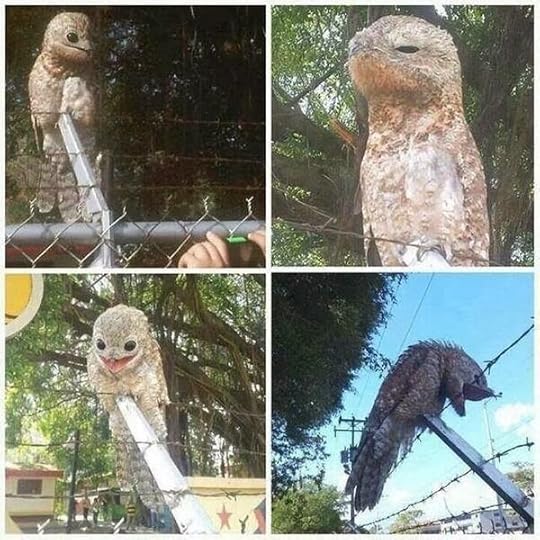 The potoo photo quartet (photos' source unknown to me)
The potoo photo quartet (photos' source unknown to me)They had been posted by FB friend Michael J. Smith, who hoped that the bird portrayed in them was genuine, and I was happy to report that indeed it was.
The taxonomic order Caprimulgiformes contains five families, whose members are generally nocturnal and insectivorous. These families are:
Caprimulgidae (the nightjars, whip-poor-wills, and night hawks – of Old World and New Worlddistribution)Podargidae (the frogmouths – exclusively Old World)Aegothelidae (the owlet-nightjars – exclusively Old World; and sometimes split off into an order of their own, Aegotheliformes)Steatornithidae (the single species of oilbird – exclusively New World)Nyctibiidae (the potoos – exclusively New World)
Looking at the four photos, I readily recognised the bird to be a potoo. True, there is a superficial similarity to the frogmouths, but having recently seen and photographed a living specimen of Australia's tawny frogmouth Podargus strigoides at very close range, I could tell the difference straight away.
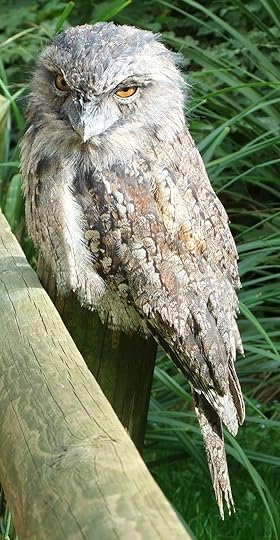 Tawny frogmouth (© Dr Karl Shuker)
Tawny frogmouth (© Dr Karl Shuker)As a good rule of thumb, whereas both bird types have strikingly large mouths, those of potoos are much bigger than their beaks whereas those of frogmouths are much the same size as theirs. And as can be seen from the photo quartet, the bird depicted in them had a very small beak in proportion to its mouth.
Eager to discover the history of these photos, I spent some time searching for details online, but little could be found. They had apparently first attracted significant online interest just a couple of days earlier, when posted on the Reddit website, and had subsequently appeared on many others worldwide. However, I discovered that they had initially appeared much earlier, having traced one site that featured them in October 2013 and another that had featured them even further back, in mid-April 2013. On a Vietnamese website that I consulted (click here ), it stated that the bird had allegedly been captured on the outskirts of a rural Venezuelan town, which if true provides further support for a potoo identity.
Judging from the comments on a range of other websites that I accessed, however, there has apparently been much wild speculation among non-ornithologists concerning the nature of this bird. Some contributors have voiced the opinion that it is an alien creature, or even a demonic entity, and others that it is an effigy or a taxiderm gaff (presumably one with a beak capable of opening and closing, judging from the differences in beak appearance present in the photos!) created specifically to fool or horrify its observers.
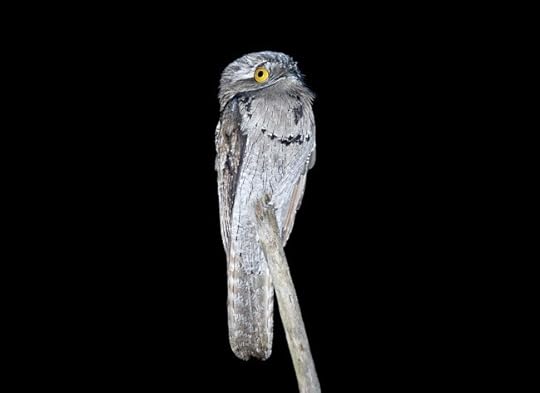 The common potoo (© Steve Gantlett/Guatemala International Birdwatching Encounter)
The common potoo (© Steve Gantlett/Guatemala International Birdwatching Encounter)In reality, however, comparing the photos with confirmed potoo images online swiftly vindicated my opinion that it is merely a potoo, most probably the common potoo Nyctibius griseus (based upon both morphological and zoogeographical correspondence)
So is the mystery of the bird with the monstrously large mouth solved? Not quite. There is still the disconcerting matter of its uniformly black eyes to consider. This is because in the eyes of potoos, the black pupil is normally prominently ringed by a wide gold-coloured iris.
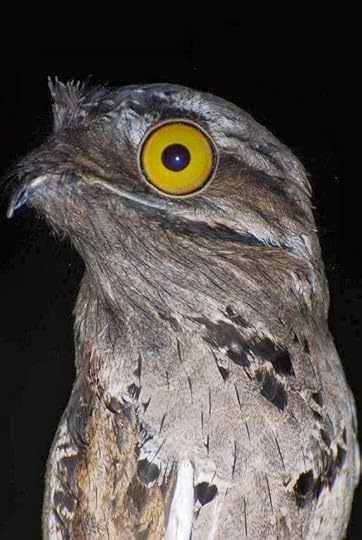 Potoo showing normal eye appearance (Barnorama)
Potoo showing normal eye appearance (Barnorama)Having said that, when I did a Google image search of photos depicting the eyes of potoos (click here ), I discovered quite a few photos of specimens with entirely black eyes. So how can this puzzling discrepancy be explained?
Could it be merely a lighting effect – the eyes appearing dark when viewed in subdued light? Bearing in mind that all potoos are nocturnal, it is more probable, however, that the pupil can dilate sufficiently in subdued light to obscure the gold iris encircling it.
Judging from the range of eye states represented in the photos thrown up in the above-mentioned Google image search, I suspect that the latter hypothesis is the correct one, but if anyone out there can offer further information, I'd greatly welcome details here.
Epilogue: on 26 January 2014, Steve Caffyn in FB's Monster Talk group offered a thought-provoking third theory:
"I think some (maybe many) bird species' eye colours change with age. My own African Grey parrot Gizmo's eyes were entirely black as a baby. Then his iris changed to white after the first year and now he is eight the iris will go increasingly yellow with age."
Finally: if you think that potoos look somewhat ghoulish, just wait until you hear what they sound like! Click here for the eldritch utterances of a great potoo Nyctibius grandis.
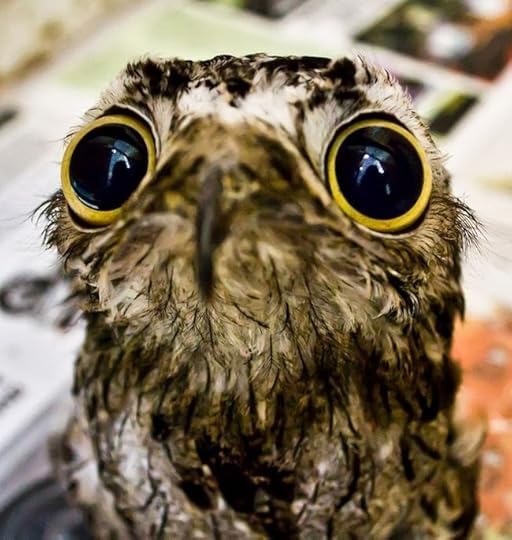 Potoo showing very restricted gold iris and very dilated black pupil (Barnorama)
Potoo showing very restricted gold iris and very dilated black pupil (Barnorama)
Published on January 25, 2014 16:33
January 23, 2014
LOOK OUT FOR THE INVISIBLE CATFISH!
 Caribbean
Treasure
(© Viking Press)
Caribbean
Treasure
(© Viking Press)There are several species of fish familiar to the tropical freshwater aquarist that are virtually transparent. These include the x-ray fish Pristella maxillaris(a species of tetra), the glass catfish Kryptopterus bicirrhis, and the ghost catfish K. minor. But what about an entirely transparent, invisible fish?
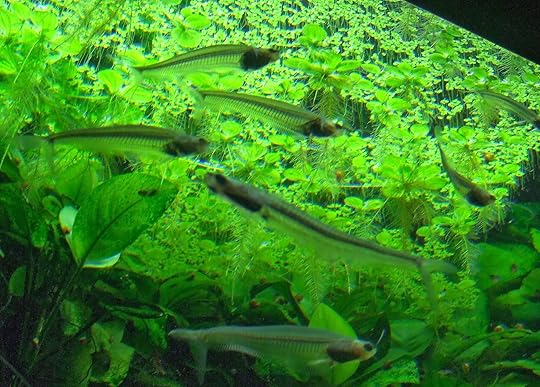 Glass catfishes Kryptopterus bicirrhis (TomCatX/Wikipedia)
Glass catfishes Kryptopterus bicirrhis (TomCatX/Wikipedia)By definition, no-one has ever seen such a creature, because if they have done, it can't have been invisible – or can it? During my cryptozoological researches, I uncovered a very intriguing account of an allegedly invisible species of catfish, encountered and reported first-hand by a well known zoologist. As will be revealed here, however, upon further investigation it turned out to be something far removed indeed from its original description.
A SEE-THROUGH SECRET FROM THE SEYCHELLES
Serendipity plays a not-inconsiderable part in cryptozoology, at least in my experience, because as has happened on a number of occasions, I came upon this particular case while investigating a totally separate one. The latter, unrelated case had been brought to my attention by Gerald L. Wood, the author of all three editions of the exhaustively-researched, still-definitive book on zoological superlatives, The Guinness Book of Animal Facts and Feats, and who was also a longstanding friend of mine. In a letter to me of 1 July 1990 that referred to a number of different mystery animals, Gerald included the following brief but tantalising enquiry:
"Do you know anything about a new species of fish that can make itself invisible? Discovered near coral reefs off the Seychelles in the Indian Ocean this mysterious creature turns from black to grey before ‘vanishing’! Apparently a pair sell for £15,000."
I had certainly never heard of it before, but knowing Gerald well, I had no doubt that this was a serious request on his part, not a joke; if he was asking me for information concerning such a fish, then he definitely believed that it existed. So I promised him that I'd look into it, and get back to him with any news that I may find. Tragically, however, this was not to be, because only a short time later Gerald died suddenly. And despite my efforts, I never did succeed in adding any details to those scant ones supplied by him.
Of course, this episode took place several years before the internet became an unrivalled source of instantly-accessible information. More recently, therefore, after recalling Gerald's invisible mystery fish and re-reading his letter referring to it, I pursued it again, but this time online, to see if anyone else had ever reported such a remarkable creature. Sadly, however, I still failed to elicit any information concerning it, but during my internet researches I did learn about what sounded like a bona fide invisible catfish, indigenous to a specific freshwater cave pool on the West Indian island of Trinidad.
IVAN SANDERSON'S NOT-SO-CRYPTIC CARIBBEANCATFISH
My source of information was a passage of text from a book entitled Caribbean Treasure, first published in 1939 (many thanks to correspondent Cameron A. McCormick for kindly providing me with a copy of the relevant passage). It was written by Ivan T. Sanderson (1911-1973) - a Scottish-born American zoologist who was also an animal collector, zoo founder, prolific nature-travel writer, and notable television personality in the States (in many ways, therefore, a direct counterpart to Britain's own Gerald Durrell).
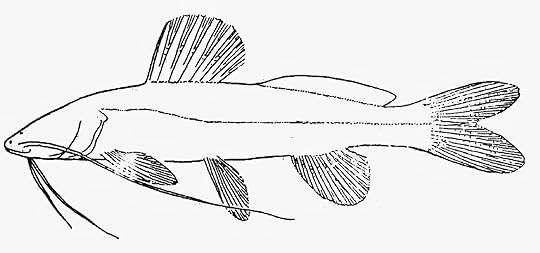 Line drawing of Caecorhamdia urichi
Line drawing of Caecorhamdia urichiAs related by Sanderson in his book, he had been conducting a field trip to Trinidad's Northern Range when he was informed by his local guides that a certain pool at the foot of the first vertical drop of Oropuche (aka Cumaca) Cave was the only known habitat of a rare, unique species of catfish that was so colourless and transparent that it could only be detected by observing its shadow passing across the bottom of the pool. Sanderson identified this elusive species as 'Caecorhandia urcihi' [sic – should be Caecorhamdia urichi], and stated that it was totally blind. Due to its invisible nature, no specimen of this catfish was captured by Sanderson or his helpers, even when using a torch beam in the hope of illuminating it somehow.
That, at least, was Sanderson's claim concerning this species. The reality, however, as I discovered when seeking out more information regarding it, is very different indeed. It was first brought to scientific attention in July 1924, when Trinidad-born naturalist Friederick W. Urich sent a specimen to London's Natural History Museum. After studying it, in October 1926 museum ichthyologist John R. Norman formally described and named its species Caecorhamdia urichi, in honour of Urich.
During the mid-1950s, six additional specimens were collected in its cave pool by Prof. Julian S. Kenny, the foremost expert on Trinidadian freshwater fishes at that time. After studying them in aquaria maintained at his home, Prof. Kenny concluded that they did not constitute a valid species in its own right but were merely a cave-dwelling (troglobite) variety of Rhamdia quelen – a species of three-barbelled catfish common in rivers throughout Trinidad.
Moreover, these six specimens varied greatly in colour, from dark grey-charcoal to pale pinkish-white. Yet all were readily visible, being quite thick in shape (as opposed to the extremely thin, flattened shape that one would expect for a reputedly transparent fish), and had therefore been easily captured. And whereas the pale specimens were indeed eyeless, the darker ones possessed small but well-formed eyes. Clearly, therefore, Sanderson's description of this catfish form was incorrect on a number of crucial counts. In addition, I remain baffled at how anything supposedly invisible by being totally transparent is able to cast a shadow anyway.
In April 1966, the plot thickened even further, when Dr G.F. Mees, a catfish expert from the Netherlands, tried to catch some specimens in their cave pool. In contrast to Kenny's experience, they proved very difficult to capture, and when he finally did procure three specimens, Dr Mees was surprised to discover that two of these were normal-coloured eyed specimens of R. quelen, and the third, although eyeless, was also normal-coloured.
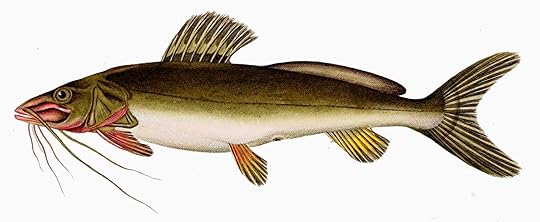 Rhamdia quelen
Rhamdia quelen
In October 2000, Dr Aldemaro Romero and Joel E. Creswell published a short article in National Speleological Society News concerning this fish and their January 2000 visit to its pool, where they observed dozens of specimens. Not one of them, however, was eyeless or of pale, depigmented colouration. On the contrary, their eyes each uniquely appeared to possess a tapetum lucidum, making them flash when illuminated by torchlight. Romero and Creswell concluded that although there may well have originally been pale, eyeless specimens here, they were probably rendered extinct following an influx of normal-coloured eyed specimens from a stream that had invaded their cave.
There is a notable precedent for this hypothesis. A population of the Mexican cave tetra Astyanax mexicanus was documented in 1983 that had originally consisted of pale eyeless specimens, but these had been wiped out in under 50 years following an influx of normal-coloured eyed specimens from a river close by.
Today, C. urichi is treated merely as a synonym of R. quelen, and the allegedly invisible nature of its former representatives as claimed by Sanderson (in what was ultimately dismissed by critics as an exercise in 'creative description') has been wholly disproved. A sad but perhaps fitting conclusion to this remarkable case – an invisible catfish that was not invisible at all in real terms, but was finally rendered so via taxonomy.
DON'T OVERLOOK THE BRAZILIAN INVISIBLE FISH!
No coverage of invisible fishes could be complete without mentioning the infamous Brazilian invisible fish. Once a staple exhibit at any travelling sideshow or display of curiosities, it was generally housed within a large water-filled goldfish bowl, and the viewing public were invited to peer closely at the bowl in case they could discern this highly elusive and rare species. Some observers couldn't spy it, which is not really surprising, because there was nothing whatsoever in the bowl except for the water!
The Brazilian invisible fish was, of course, a hoax. It first attracted notable attention when Harry Reichenbach (1882-1931), an American publicist, used this scam in order to attract potential customers to a poor woman's restaurant, by placing the bowl and a big sign advertising it in the store's window.
Amazingly, however, there would always be those who were adamant that they had definitely seen something move inside the bowl - and sometimes that was actually true. This was because Reichenbach would strategically place a small electric fan out of sight but near enough to the bowl to create a faintly visible ripple passing through the water). All of which goes to prove that just as there are none so blind as those who do not want to see, equally there are none so perceptive as those who do want to see. A noteworthy cryptozoological caveat?
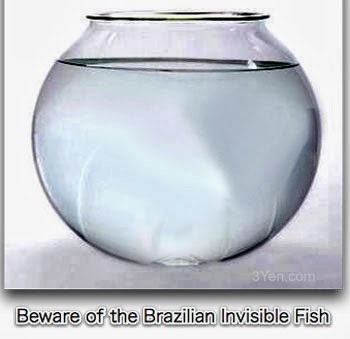 Beware the Brazilian invisible fish (© http://news.3yen.com/2009-12-29/is-tr...)
Beware the Brazilian invisible fish (© http://news.3yen.com/2009-12-29/is-tr...)This ShukerNature article is excerpted exclusively from my forthcoming book The Menagerie of Marvels: A Third Compendium of Extraordinary Animals, to be published later this year by CFZ Press.
Published on January 23, 2014 14:52
January 10, 2014
EXPOSING ONLINE FAKES AND FRAUDS OF THE CRYPTOZOOLOGICAL KIND – A SHUKERNATURE TOP TEN LISTING
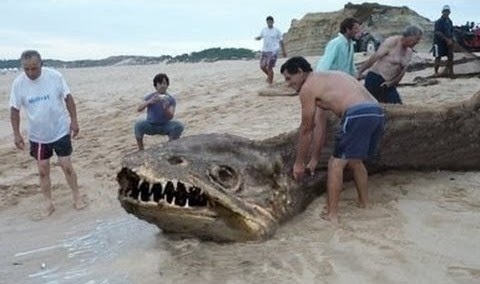 A monstrous discovery? (© Alan Friswell)
A monstrous discovery? (© Alan Friswell)The internet is the natural home of some very unnatural creatures – fakes, frauds, and the falsely identified. Many of them attract only fleeting, transient attention before being soundly exposed and permanently discredited. However, there is also a hardcore set whose members simply refuse to die – being revived time and time again by unsuspecting novice researchers who are bewitched by their superficial strangeness and fail to realise that their faux nature has been unveiled on numerous previous occasions. So here, in no particular order, are ten of the most noteworthy (and notorious) examples, all of which I have investigated at one time or another and have either personally exposed the truth behind them or have discovered who else has done so.
#1 - A LIVING SEA SCORPION?
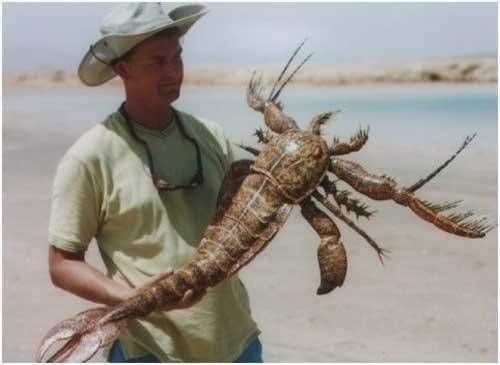 (© Crawley Creatures)
(© Crawley Creatures)And where better to begin than with this extremely striking photograph? As can be seen, it portrays someone holding what appears on first sight to be a recently-dead eurypterid or sea scorpion, which, if genuine, would be an astonishing discovery, bearing in mind that the most recent confirmed specimens died out during the Permian-Triassic mass extinction approximately 252 million years ago. I have seen the following report accompanying this photo on several Facebook group and individual pages, but its earliest online appearance seems to be on the Paranormal Geeks Radio website on 13 April 2013. Here's the report:
"In 1971 farmer Ted Litton caught this weird animal alive in his artificial pond in Lilac, TX, & got his pic in the paper. 8 hours later his farm was besieged by Army soldiers wearing decontamination suits. They drained the pond, leaving an odd, spheroid cavity in the bottom. Litton says the Army dismissed his beast as a freak of nature yet they confiscated it, promising him 5 grand (which never materialized).”
Needless to say, however, as I discovered when subjecting this photograph to a Google Image search, the reality soon proved to be very different. In fact, the eurypterid was a prop, an animatronic model, to be precise, produced for the BBC television series Sea Monsters (2003) by the award-winning special-effects design company Crawley Creatures, based in the UK. Here is a link to their website that shows this exact-same photograph:
http://www.crawley-creatures.com/Gallery.aspx?Job=70
As for the eurypterid model, it represents the Ordovician genus Megalograptus, which is one of the earliest eurypterids on record.
#2 – THE NORTH AMERICAN BLACK PANTHER FROM SOUTH AFRICA
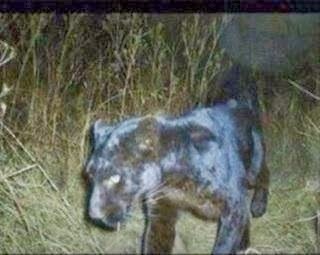 (© Kevin Richardson)
(© Kevin Richardson)Since the beginning of October 2013, the above photograph has been circulating widely online, appearing not only in a number of Facebook groups but also on a wide variety of websites, many of which claim that the black panther (i.e. melanistic leopard) that it depicts was recently photographed in the wild somewhere in North America. It is precisely where that has incited controversy, with a number of different States variously cited, including Oklahoma, Louisiana, Georgia, Tennessee, and Texas. Once again, however, after subjecting the photo to a Google Image search I swiftly uncovered its true provenance, which proved to be South Africa. Indeed, as I discovered from the following online article, dated 20 March 2013, which contains and originated this photo:
http://showme.co.za/nelspruit/news/chasing-mpumalangas-black-leopard/
the animal in question is a black panther named Coal, one of two (both born in 2003) present in captivity and in the care of conservationist Kevin Richardson at the Dinokeng Nature Reserve in Gauteng, South Africa. Clearly, therefore, person(s) unknown had subsequently utilised the photo in fake reports claiming that it had been snapped in North America.
#3 – THE HUMAN-DOG HYBRID
 (© Patricia Piccinini)
(© Patricia Piccinini)This extraordinary photograph has been the subject of much online speculation since as far back as 2005, and has even featured in various YouTube videos. Lurid claims that its subjects were bona fide human-canine hybrids are widespread, and also that it is a skilfully-produced Photoshop creation. In reality, neither of these is correct, because what it really is…is a very remarkable sculpture, as revealed in the following link:
http://urbanlegends.about.com/library/bl_half_human.htm
As explained there, the sculpture is entitled 'The Young Family', and was created by Australian artist Patricia Piccinini in 2002. It was manufactured from silicone, polyurethane, leather, plywood, and human hair, measures 80 x 150 x 110 cm, and is part of a larger work entitled 'We Are Family'.
#4 – THE WORLD'S LARGEST TORTOISE?
 (© Kadokawa Pictures)
(© Kadokawa Pictures)This memorable photograph recently re-appeared in the following online article, dated 18 December 2013:
http://news-hound.net/world-largest-tortoise-found-in-amazon-basin-800lb/
but it has been circulating online in similar accounts for quite a while prior to that (I have found web reports of it dating back as far as August 2012). The article claims that this mega-tortoise had been discovered in a Brazilian river in 1892, but was around 529 years old. As anyone familiar with Japanese 'monster' films would soon confirm, however, the photo is merely a still from the popular movie Gamera the Brave, produced in Japan by Kadowara Pictures in 2006 – as verified by the following French website page:
http://www.cinemotions.com/photos-n004-Gamera-l-heroique-tt80971
#5 – BLACK LION 'FAUX-TOGRAPHS'
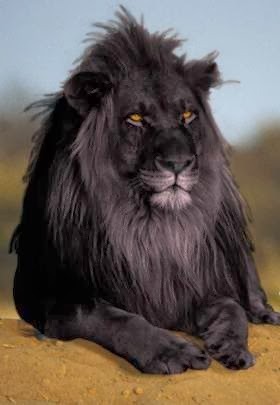 (?© martincito1/tumblr.com)
(?© martincito1/tumblr.com)Four separate photographs of alleged black lions have been circulating online for more than 2 years, and as I have documented in my books Mystery Cats of the World (1989) and Cats of Magic, Mythology, and Mystery (2012), several unconfirmed sightings of such animals have been reported from various regions of Africa, but no verified specimen has ever been documented. So what were the animals in the online photos? As I revealed in two exclusive ShukerNature investigations:
http://www.karlshuker.blogspot.co.uk/2012/06/black-lions-manipulation-melanism-and.html
and
http://karlshuker.blogspot.co.uk/2012/10/exposing-another-black-lion-photograph.html
three of these four black lion photographs were photoshopped versions of original images depicting normal, tawny-coloured lions. And the fourth black lion photo was a photoshopped version of an original image of a rare white lion – I successfully tracked down all four of the original images online.
#6 – MULTI-HEADED COBRAS
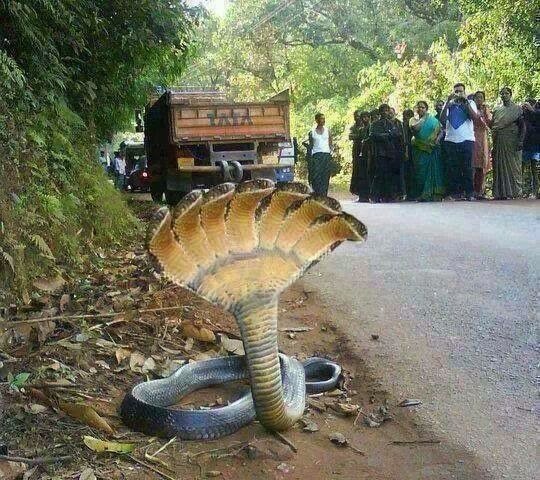 (original source/copyright holder unknown to me)
(original source/copyright holder unknown to me)Another popular, perennial subject represented online by a wide variety of fake images is the multi-hooded (and –headed) cobra. Claimed in some reports to constitute living nagas or Indian snake deities, they were, as I soon revealed in another ShukerNature investigation:
http://www.karlshuker.blogspot.co.uk/2012/03/modern-day-nagasor-photoshopped-frauds.html
to be nothing more than clever Photoshop creations. Indeed, there is even a video on YouTube that provides a step-by-step guide on how to create your very own multi-hooded cobra 'faux-tograph'.
#7 – THE GIANT SEA SERPENT OF TAKESHI YAMADA
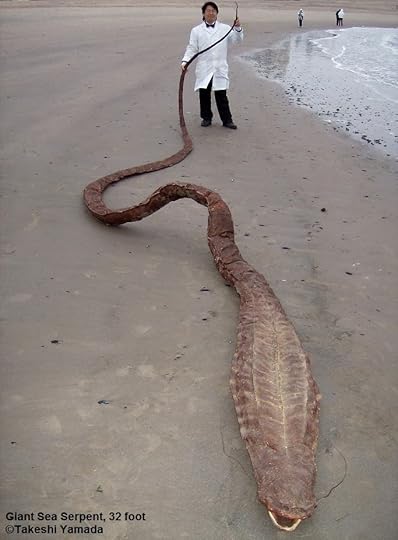 (© Dr Takeshi Yamada)
(© Dr Takeshi Yamada)This very spectacular photo has incited much discussion online in recent years – which is very strange, bearing in mind that even the most cursory Google Image search will rapidly reveal that the 32-ft-long sea serpent depicted in it is in reality a very adept creation of master monster-maker Dr Takeshi Yamada. Indeed, as I revealed in the following ShukerNature article:
http://www.karlshuker.blogspot.co.uk/2011/06/giant-sea-serpents-and-chupacabra.html
it is just one of many fascinating examples of so-called rogue taxidermy produced over the years by Yamada. Others include a chupacabra snail, a vampire monkey, a Mongolian death worm, a whip-tailed tree octopus, and an eight-legged spider dog!
#8 – EXPLAINING A VERY FISHY SEA SERPENT - A SHUKERNATURE EXCLUSIVE!
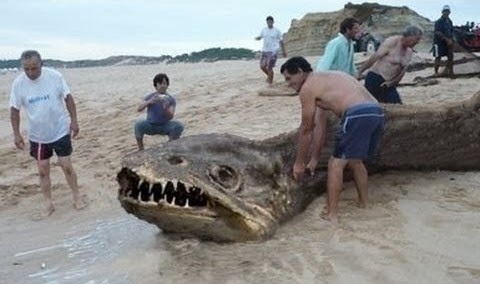 (© Alan Friswell)
(© Alan Friswell)In stark contrast to Yamada's example, this eyecatching sea serpent photograph has greatly perplexed many people (and continues to do so), judging from the contradictory claims and comments concerning it that have appeared in online discussions and even in YouTube videos. Its portrayed location has been variously stated to be a beach in Hawaii, South Australia, and the Philippines. Moreover, no-one has been able to identify the creature that the photo depicts, but some bizarre suggestions have been offered, including an oarfish – which looks nothing like it! Happily, however, this photo poses no such problems for me – because, as now exclusively revealed here on ShukerNature, I just so happen to know who created it! None other than a good friend of mine, expert monster/dinosaur model-maker Alan Friswell, as he revealed to me in October 2013:
"I drew this sea serpent in photoshop in 2009, to accompany an article that I wrote for the CFZ [Centre for Fortean Zoology] blog page."
Evidently, therefore, it had subsequently been lifted by person(s) unknown and passed off by them as a real, unidentified creature. This is exactly how so many online cryptozoological hoaxes arise. Someone like Alan innocently creates a fictitious beast as artwork, but then other persons deliberately pass it off as a genuine animal. Indeed, this is precisely what happened with some of the black lion photos too, and also with the next case in our listing.
#9 – ARACHNOPHOBES BEWARE - THE ANGOLAN WITCH SPIDER
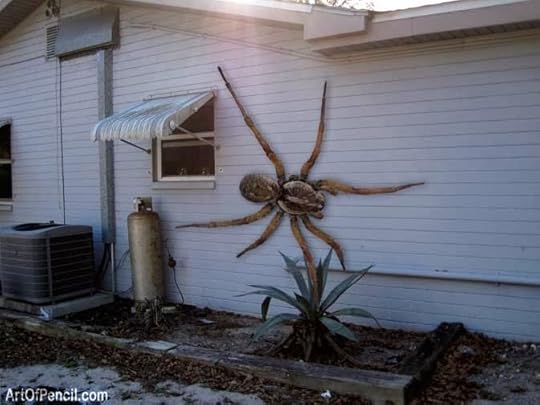 (© Paul Santa Maria)
(© Paul Santa Maria)This dramatic photograph must have sent shivers down the spine of many an arachnophobic viewer since it first appeared online more than 2 years ago. It often appeared with an account describing it as an Angolan witch spider. Here's one version of that account:
"It's a new spider called the Angolan witch spider. They migrated from South America [very odd, since Angola is in Africa!]. They primarily eat dogs and cats. In Texas this abnormally large spider was found on the side of this home. It took several gun shots to kill it."
When I first saw the photo a year or so ago, I readily identified its subject as a wolf spider, albeit one of wholly implausible size. And sure enough, a little online detective work on my part soon traced the truth behind the terror, as fully documented in the following website account:
http://www.hoax-slayer.com/angolan-witch-spider.shtml
It reveals that the photograph was produced via Photoshop as a joke by artist-musician Paul Santa Maria, who uploaded it onto his Facebook page, where it remained for just a few hours before he took it down again. But that was still sufficient time for it to be copied by someone onto their own page, from where it soon went viral. The bogus account of it being an Angolan witch spider was attached to it by person(s) unknown – and the rest, as they say, is history.
#10 – THE RAINBOW OWL IS A HOOT!
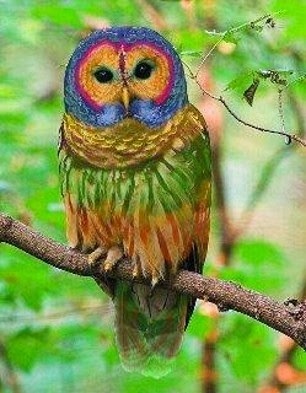 (copyright holder unknown to me)
(copyright holder unknown to me)A year ago, several correspondents alerted me to the above photograph and an accompanying report, circulating on Facebook and elsewhere online, concerning what was claimed to be a rare but remarkable species of owl. It is known as the rainbow owl on account of its gaudy, multicoloured plumage, and according to the report it is native to the USA and China (an oddly discontinuous zoogeographical distribution, to say the least!) but was hunted into near-extinction during the early 20th Century due to coveters of its beautiful feathers. Moreover, it has an unusually melodious call, and is so attracted to music and human singing that researchers seeking it in the field know that they will greatly increase their chances of finding specimens if they bring along a portable stereo. The author of this intriguing report was one Dr Claudia Weatherfield of the University of Toldeo.
Needless to say, as someone with a longstanding ornithological interest yet who had no prior knowledge whatsoever of any such species, I was instantly suspicious. And rightly so, as it turned out, because some online investigations soon led me to the following webpages contained on two websites devoted to exposing hoaxes, and which fully justified my concern:
http://www.snopes.com/photos/animals/rainbowowl.asp
http://urbanlegends.about.com/od/animalkingdom/ss/Rainbow-Owl.htm
They revealed that there is no University of Toldeo; nor any Claudia Weatherfield working even at the similarly-named University of Toledo. The photograph was clearly a computer-modified version of some other image, and sure enough the original photo proved to be of a barred owl Strix varia - a common North American species unadorned by any rainbow-hued plumage.
Who knows – perhaps now, finally, all of these tenacious phoneys will be laid to rest forever…but with their exceptional history and capacity for resurrection, I wouldn't bet on it!
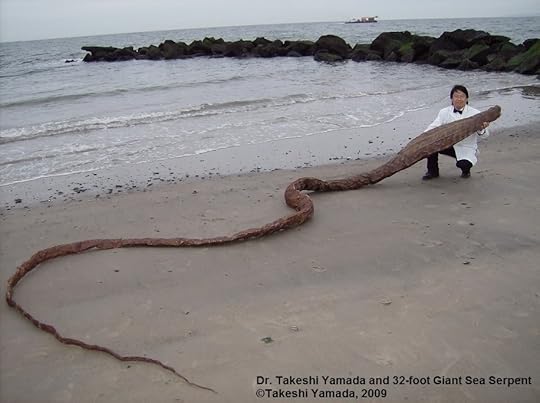 Another photograph of Dr Takeshi Yamada's incredible 32-ft sea serpent (© Dr Takeshi Yamada)
Another photograph of Dr Takeshi Yamada's incredible 32-ft sea serpent (© Dr Takeshi Yamada)
Published on January 10, 2014 17:15
Karl Shuker's Blog
- Karl Shuker's profile
- 45 followers
Karl Shuker isn't a Goodreads Author
(yet),
but they
do have a blog,
so here are some recent posts imported from
their feed.



